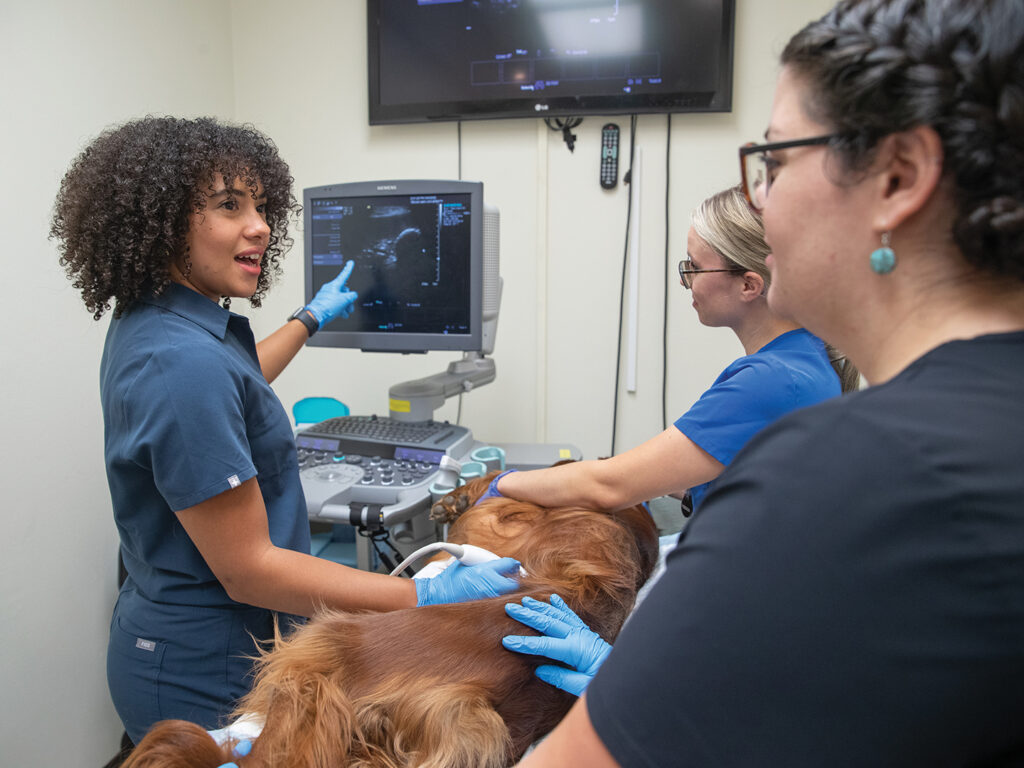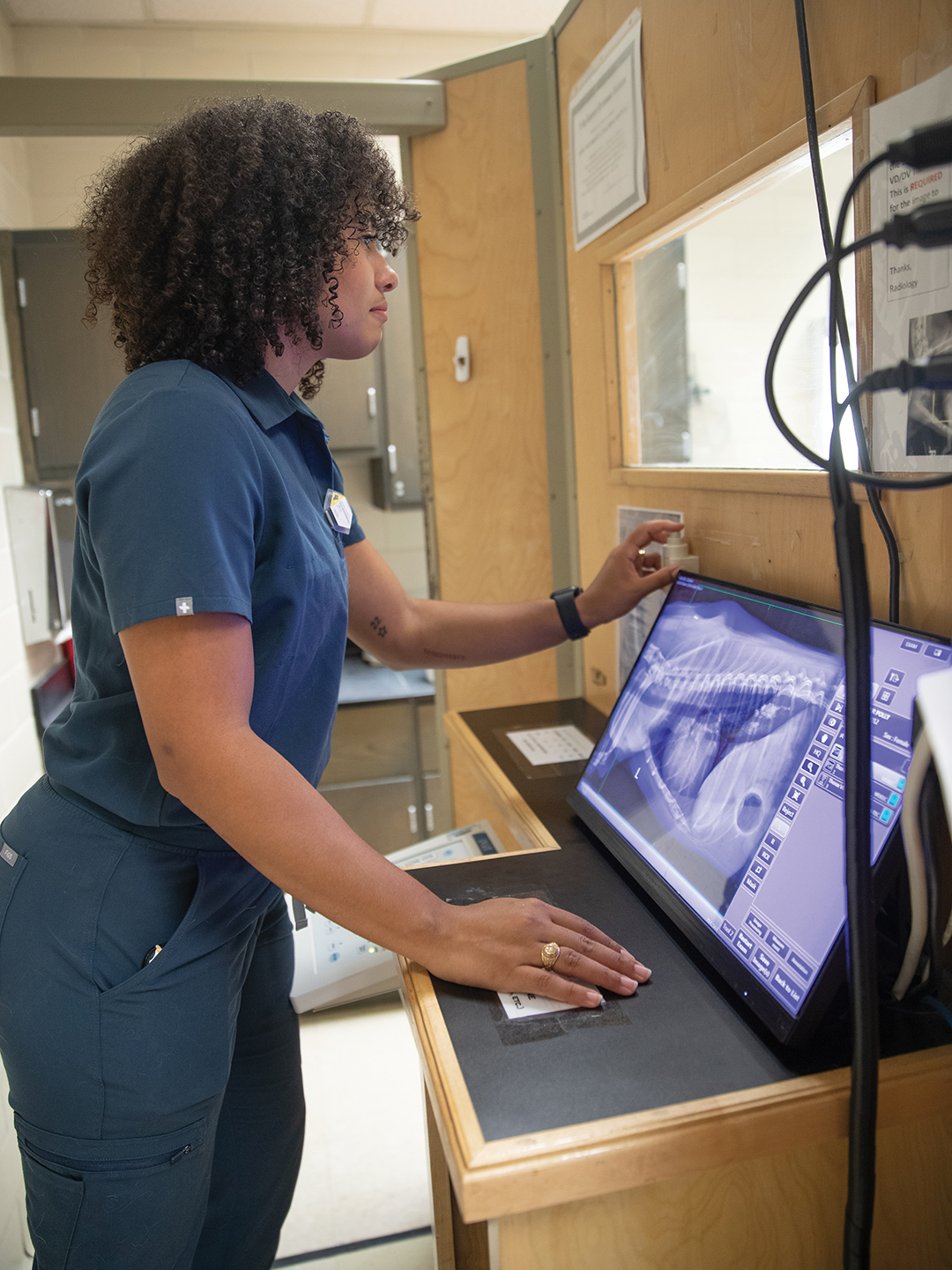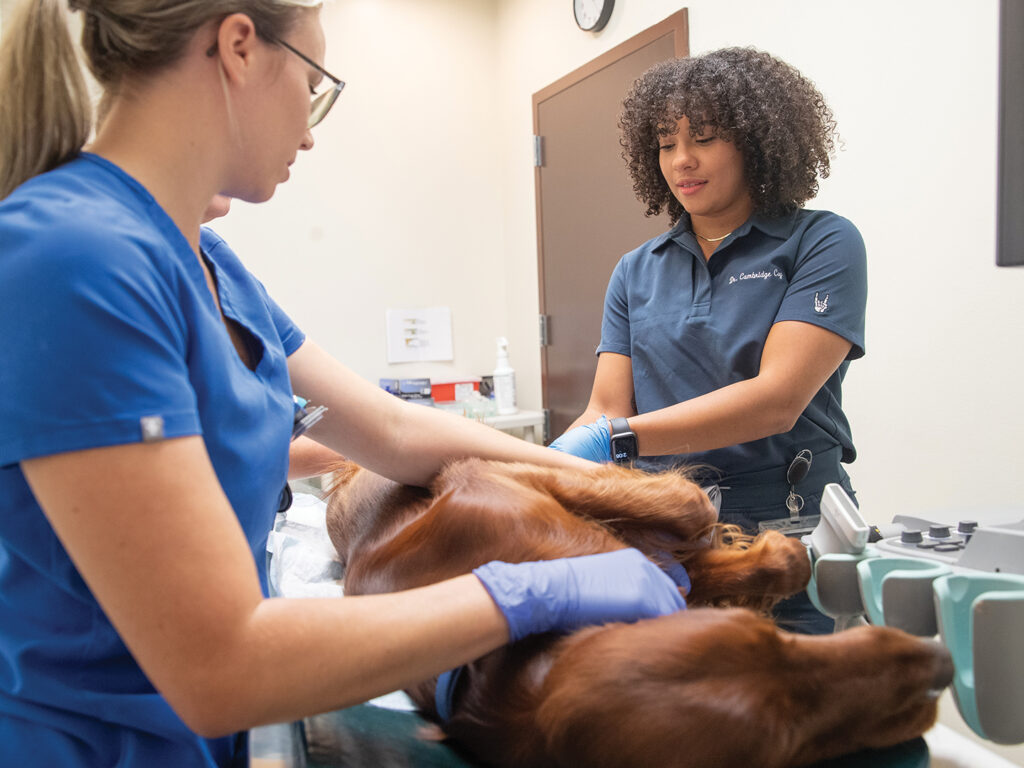Aggie Veterinarian Explores Her Love For Radiology With Small Animal Rotating Internship
Story by Megan Myers, VMBS Communications

Dr. Cambridge Coy ’22 has known since her second year as a student at the Texas A&M School of Veterinary Medicine & Biomedical Sciences (VMBS) that she wanted to become a veterinary radiologist.
In the years since then, her classes, part-time jobs, and time as a rotating intern at the VMBS’ Small Animal Teaching Hospital (SATH) have only strengthened her goal.
One of her most influential experiences, however, was a research project she hadn’t originally planned on doing.
During Coy’s final year of veterinary school, Dr. Jay Griffin, a VMBS associate professor of veterinary radiology, invited her to join him in studying CT scans of dogs with American canine hepatozoonosis (ACH), a rare infectious disease.
Dogs acquire ACH after eating an adult Gulf Coast tick infected with a protozoan known as Hepatozoon. The condition is known to cause fever, weight loss, nonspecific pain, and lethargy and can sometimes be fatal. Unfortunately, the disease also can be difficult to definitively diagnose because of imprecise and costly testing methods.
Coy and Griffin were investigating an additional finding of ACH that may also hold a clue to an earlier diagnosis—strange bone growth visible in CT scans.
“Very few clinicians image the spine of dogs with this condition because no one ever thought there was a reason to,” Coy said. “However, we found four cases where the clinicians ordered CT scans of the spine, looking for causes of spinal pain, and the dogs were later diagnosed with this rare infectious disease. All four of those dogs had the same weird changes to their spine.”
The dogs in their study had proliferative lesions on their spinal vertebrae, specifically coming from the periosteum, a complex fibrous membrane of blood vessels and nerves that wraps around bones. These lesions seemed to appear without any other identifiable cause besides ACH and were not cancerous or otherwise destructive.
Although no one knows why, it is well documented that this proliferation can often be seen on long bones of the legs, such as the femur, humerus, and tibia.
Because CT scans are becoming more common in veterinary medicine, spinal scans like those used in this study may become an effective tool for creating an earlier suspicion of ACH.
On a more personal level, the project gave Coy a new outlook on the impact radiology can have in veterinary medicine, and she was listed as the first author on the published case report, an impressive feat for any student.
A Unique Path

Like many others who go on to pursue a Doctor of Veterinary Medicine degree, Coy wanted to become a veterinarian for as long as she can remember, which some friends and family considered odd, since she wasn’t allowed to have pets growing up.
Coy was raised by her grandparents in the small town of Kaufman, Texas, and her grandmother was terrified of anything with four furry legs. So, when she was accepted into veterinary school, everyone was shocked.
“My grandmother asked, ‘Are you really going to go?’ and I replied, ‘Yeah, I’ve only been talking about it for 20 years!’” Coy said.
Coy attended Rogers State University in Oklahoma for her undergraduate degree in medical molecular biology, which provided a distinct, One Health perspective for entering veterinary school.
“We had normal classes like anatomy and physiology, but there was also a strong emphasis on botany and zoology because Rogers State has a strong focus on the environmental science,” she said. “There’s even a nature reserve on campus.
“The animal classes available to me were very different from the animal science program here at Texas A&M because I didn’t have nutrition or any husbandry classes. It was more like wildlife, taxonomy, and native Oklahoma ecology,” she said. “I was actually the only student in my class interested in veterinary medicine.”
These classes gave her a unique perspective that also upheld an interest in wildlife medicine and exotic animals, an area she continued to pursue throughout veterinary school. She even took the time to become a certified postmortem sample collector for Chronic Wasting Disease, a fatal disease that affects members of the deer family.
During that time, she also took advantage of any opportunities that helped her become more comfortable working with large animals.
“No pets growing up also meant no large animal experience,” she said. “I wouldn’t have made it through my equine skills labs without Dr. Glennon Mays taking the time to teach me how to relax around horses.”
It wasn’t until her second year at the VMBS that she would narrow her fascinations and cultivate a true passion.
Visualizing Her Career
When Coy began her Introduction to Diagnostic Imaging class in the spring of her second year, she was surprised to find a hidden talent for reading radiographs, a skill many veterinary students struggle with at first.
“Diagnostic imaging is really hard, but I actually enjoyed the challenges,” she said.
She decided to pursue this subject further by starting a part-time job in the SATH’s Diagnostic Imaging Service.
“I took all of the radiographs after hours for the Emergency and ICU Services, so I saw a lot of chests, abdomens, and broken bones,” Coy said. “It was a really great job and the supervisors were awesome and really accommodating. I got to meet a lot of the faculty I needed to know moving into fourth year, so that was cool, too. It just further solidified that I wanted to be a radiologist.”
Before being able to apply for a radiology residency, Coy needed to complete a rotating internship like the one offered at Texas A&M, which allows new veterinarians to rotate through the SATH’s many services while continuing to get mentorship and guidance from VMBS faculty members.

“It’s very important to me that I am a good clinician before pursuing my specialty,” she said. “I’ve learned the impact a radiologist has on patient care and treatment plans. While I am excited for the future, I’ll cherish this time working with other specialties and hope to work somewhere that lets me interact with other specialties often.”
To no one’s surprise, Coy’s favorite service to rotate through was diagnostic imaging, and from her experiences with radiology, she can pinpoint a couple types of cases as her favorites to image.
“Cancer can do really crazy things and always makes very interesting scans,” she said. “Checking for cancer metastasis on advanced imaging can be unpredictable and it is amazing what these horrible little cells can do. From an imaging perspective, you’re constantly kept on your toes. I hope one day I can use this fascination with cancer in diagnostic imaging to further the collective efforts of oncologists to diagnose and treat cancer earlier and more effectively.”
Coy’s next adventure will involve completing a Diagnostic Imaging residency at the University of California, Davis, School of Veterinary Medicine. After that, she is considering staying within academia or using teleradiology to reach a larger clientele.
“I love the discussions that academia provides, and you get a lot more follow up with your cases compared to teleradiology. That’s really important to me and I think it helps with accuracy and learning,” Coy said. “Teleradiology is also very important for helping people and their pets who don’t have access to a full team of specialists. You get to help people from all over the place—even different countries—and that’s what all of this is really about.”
###
Note: This story originally appeared in the Winter 2023 edition of VMBS Today.
For more information about the Texas A&M College of Veterinary Medicine & Biomedical Sciences, please visit our website at vetmed.tamu.edu or join us on Facebook, Instagram, and Twitter.
Contact Information: Jennifer Gauntt, Director of VMBS Communications, Texas A&M College of Veterinary Medicine & Biomedical Sciences; jgauntt@cvm.tamu.edu; 979-862-4216


